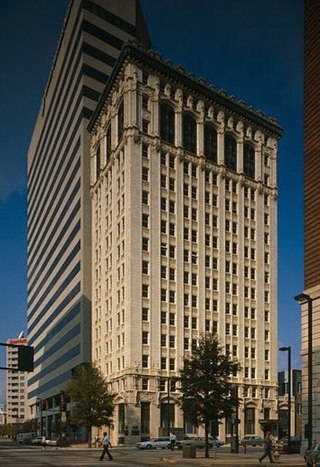Related Research Articles

Jules Jacques Benois Benedict was one of the most prominent architects in Colorado history, whose works include a number of well-known landmarks and buildings listed on the National Register of Historic Places.
William Augustus Edwards, also known as William A. Edwards was an Atlanta-based American architect renowned for the educational buildings, courthouses and other public and private buildings that he designed in Florida, Georgia and his native South Carolina. More than 25 of his works have been listed on the National Register of Historic Places.

George Richard Mann was an American architect, trained at MIT, whose designs included the Arkansas State Capitol. He was the leading architect in Arkansas from 1900 until 1930, and his designs were among the finalists in competitions for the capitols of several other states.
Tourtellotte & Hummel was an American architectural firm from Boise, Idaho and Portland, Oregon.
Hobart Brown Upjohn (1876–1949) was an American architect, best known for designing a number of ecclesiastical and educational structures in New York and in North Carolina. He also designed a number of significant private homes. His firm produced a total of about 150 projects, a third of which were in North Carolina.
Benton & Benton was an architectural partnership in eastern North Carolina of brothers Charles C. Benton Sr. and Frank W. Benton. Several of its works are listed on the U.S. National Register of Historic Places. Charles C. Benton Jr. and others also worked for the firm.

Alexander Blount Mahood was a Bluefield, West Virginia-based architect.

Harry Barton was an American architect in North Carolina.

Wing & Mahurin was an architectural firm of Fort Wayne, Indiana. Its principal partners were John F. Wing (1852-1947) and Marshall S. Mahurin (1857-1939), who were partners until 1907. Together with Guy M. Mahurin (1877-1941) they worked also as Mahurin & Mahurin.
Charles C. Wilson, whose full name is Charles Coker Wilson, was an American architect based in Columbia, South Carolina. Wilson was born in Hartsville, South Carolina, and graduated from South Carolina College with an engineering degree in 1886, continuing on to receive his master's degree in 1888. He briefly studied architecture in the Atelier Duray at the École des Beaux-Arts in Paris. Much of his work contained Beaux-Arts elements. Architects who worked for Wilson include Joseph F. Leitner, during 1901–1905, who became a noted architect in Wilmington, North Carolina; and Henry Ten Eyck Wendell, during 1905–1906.

The Lydia Plantation, also known as the Benjamin Sydney Josey Farm, in Lydia, South Carolina is a historic plantation and house. The house was designed by Charles Coker Wilson and his firm Wilson, Sompayrac & Urquhart. It was built in 1910 and expanded in 1920.

The Palmetto Building, built during 1912–1913, is an early skyscraper in Columbia, South Carolina. It was designed by architect Julius Harder, and Wilson and Sompayrac served as supervising architects. Upon completion it was the tallest building in South Carolina at 215 ft (66 m) and with 15 floors.
Earle Sumner Draper (1893–1994) was an American town planner and a landscape designer, who is famous for having coined the term "urban sprawl".

Julius F. Harder was an American architect based in New York City. He was a principal in the firm Isreals & Harder. Before starting his own firm with Isreals, Harder had worked for architect John Rochester Thomas.
Louis H. Asbury (1877–1975) was an American architect, a leading architect of Charlotte, North Carolina. He is asserted to be the "first professionally trained, fulltime architect in North Carolina who was born and practiced in the state."
James C. Holland (1853–1919), commonly known as J.C. Holland, was an architect in the U.S. state of Kansas.
W.G. Wilkins Co. was an architectural and engineering firm of Pittsburgh. It was headed by William Glyde Wilkins.

Frankel & Curtis was an architectural firm of Lexington, Kentucky. It was a partnership of Leon K. Frankel and of John J. Curtis, along with associates James Slaughter Frankel and Melbourne Mills. A successor name is Frankel, Curtis & Coleman. Under this name, the firm received a 1963 American Institute of Architects Kentucky award, its Honor Award merit prize, for its Admin. Bldg., of the Spindletop Research Center, in Lexington, Kentucky.
Charles Christian Hook (1870–1938) was an American architect. He was also the founder of FreemanWhite, Inc. a Haskell Company (1892), the oldest practicing firm in North Carolina and currently the 11th oldest architecture firm in the United States.
Willard Close Northup (1882–1942) was an American architect in North Carolina who was the principal partner in the firm Northup & O'Brien. His firm was based in Winston-Salem, North Carolina. Northup began his architectural practice in 1906 and partnered with Leet Alexander O'Brien (1891–1963) in 1915 or 1916. Luther Lashmit joined the firm in 1927, and was lead architect for Graylyn while an employee of the firm.
References
- ↑ American architect and architecture, Volume 115. J.R.Osgood & co. 1919. p. 389.
- ↑ John E. Wells and Catherine W. Bishir (2010). "North Carolina Architects and Builders: Charles C. Wilson". NCSU Libraries.